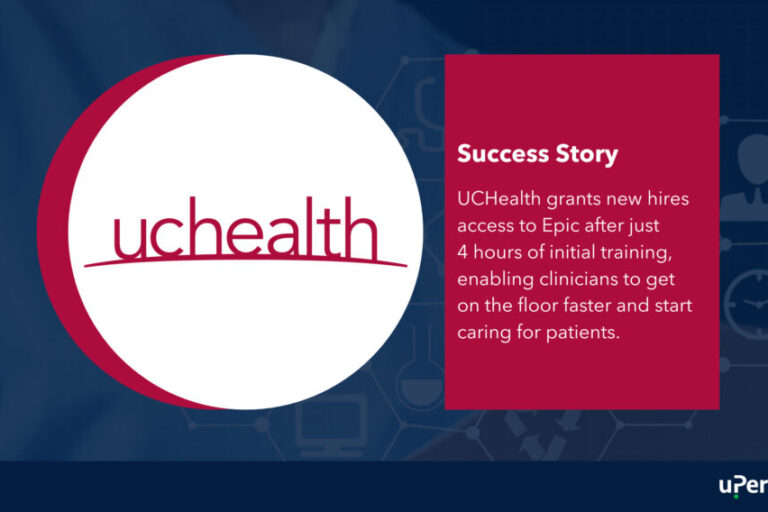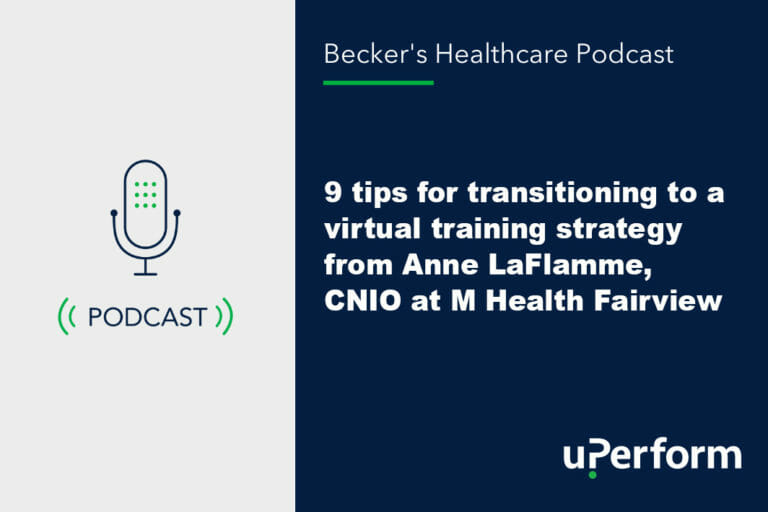Between staffing shortages and shrinking budgets, healthcare staff are being asked to do more with less. How can IT and training teams better support clinicians in their use of technology when they themselves are often understaffed and working with tight budgets?
Gundersen Health’s training team is no stranger to delivering efficiency. Faced with limited training staff and classroom space in the wake of COVID-19, the team overhauled their training strategy in favor of a more scalable solution that accelerated their onboarding and offered better ongoing support for clinicians. The new strategy has paid dividends for the training team, the clinicians it supports and the Gundersen Health organization as a whole, and they feel better prepared to face the challenges ahead of them today than ever before.
Join uPerform’s Liz Griffith alongside Bethany Poellinger, Katie Burroughs and Katie Schillinger from the Gundersen Health training team as they discuss their journey to scale their Epic training program to deliver more value with less resources.

Bethany Poellinger, MBA
Sr. Instructional Designer

Katie Burroughs
Sr. Instructional Designer

Katie Schillinger
Sr. Instructional Designer
Scaling training and upskilling trainers to keep pace with growth
Like many others, Gundersen Health’s journey to overhaul its training strategy began at the onset of COVID-19. They had less classroom space, a sudden need for social distancing and an increased demand for cross-training and onboarding.
Forced to reassess its training approach, Gundersen Health implemented uPerform in October 2020 to enable a digital training strategy. They initially prioritized the creation of courses and simulations for rapidly onboarding affiliate partners and new hires. This allowed their training team to be in many places at once.
“We found a great deal of efficiency with folks, because instead of having 15 trainers in 10 computer labs, we instead could have 2 or 3 trainers in different computer labs with many roles in those rooms taking the courses.”
— Bethany Poellinger

As a large health system, Gundersen Health is spread across three states. Schillinger shares how this new model has also saved Gundersen significant time and costs associated with traveling to training sessions.
“New staff was having to travel long distances for many, many days in a row, potentially, to be able to complete their Epic training. And now, since we’re able to do those modules remotely, it takes a lot of burden off the affiliate and the regional sites. Financially, not having to pay mileage and things like that, as well as just time. It gets the new employees into their departments more quickly, because they can complete their stuff at their own site.”
— Katie Burroughs
Gundersen discovered yet another benefit of their new digital training strategy. Trainers had previously been “super siloed,” says Poellinger, meaning that they were certified in specific Epic modules and were not comfortable assisting clinicians outside of their specialties.
The reduced demand on classroom instruction has since allowed trainers to learn more about other Epic modules and offer support where it’s needed. With the simulations and courses that Gundersen Health’s training team created, trainers can learn more about various Epic modules and increase their value to the clinical staff. It’s allowed them to expand the trainer role to allow for one-on-one coaching opportunities with clinicians who benefit from additional support.
The transition to a digital training strategy proved to be a success for delivering quality training through the pandemic and onboarding new affiliates while also reducing the strain on the training team.
Onboarding new hires and getting them on the floor 75% faster

“We had new hires that were sometimes waiting two, three, four, five days to even get their Epic training. And without Epic training, they cannot access Epic. So, we were really causing a lag in people hitting the floor and starting their work.”
— Katie Schillinger
It’s an all-too-common challenge facing many organizations today, as healthcare turnover surges and resources remain limited. It’s essential that organizations keep pace with onboarding demands so they can onboard new hires, cross train and backfill as needed and avoid the costly backlog of staff waiting to receive training and start work.
Gundersen Health soon expanded its new digital onboarding strategy to its front desk and scheduling staff. This used to comprise of three to four days of Epic training. The training included front desk staff, schedulers and anyone who touched patient registration. The training was not specific to role and often included lessons that were not relevant to everyone in the class.
With their new self-paced digital onboarding model, some of those new hires, such as schedulers, now complete their initial Epic training in one day. Gundersen Health was able to break the lesson plan into modules, so new hires don’t need to sit through any lessons that aren’t relevant to their role.
It’s helped them tailor the onboarding experience for clinical staff, as well. Clinicians who already have experience with Epic can spend more or less time on certain lessons, depending on what training they need.
With a self-paced onboarding model, Gundersen Health is reducing the time new hires spend in training and getting them on the floor faster.
Improving access to ongoing training and support materials
Gundersen Health has also found success in improving its access to ongoing training and support materials. With uPerform’s just-in-time delivery of training and support content, users at Gundersen Health have access to role-based simulations, courses, tip sheets and more whenever they need it. With uPerform’s Epic integration, that content is accessible directly in their workflow. It’s allowed Gundersen to focus on ‘what you need to know’ in its onboarding and encourage a self-help approach for ongoing training.
Clinicians already had access to an Epic support line, available Monday through Friday during normal business hours. The addition of uPerform’s just-in-time capabilities has provided clinicians with round-the-clock access to the help resources they need. It has also helped the support line staff improve the quality of their support.
Schillinger describes one situation where clinicians often get hung up – what they call an erroneous encounter.
“If they don’t get a live trainer, they’ll leave a message. I’ve had multiple providers where I’ve called them back, and they’re with a patient. So, rather than continuing to play phone tag, I send them the instructions for how to do an erroneous encounter. They can view it on their own time; they’re not having to try to squeeze me in between patients.”
— Katie Schillinger
For Gundersen, online virtual training has not replaced trainers. Rather, it’s allowed those trainers to be in more places at once, deliver more value to the organization and improve access to support for clinical staff.
Related Articles
Stay on top of training demands with uPerform
Looking for a more scalable training solution that gives your clinicians support they’re looking for? uPerform is working with health systems around the world to enable just-in-time delivery of training materials to clinicians. Schedule a demo and learn more about how uPerform can work with your EHR, HCM, ERP and more.













